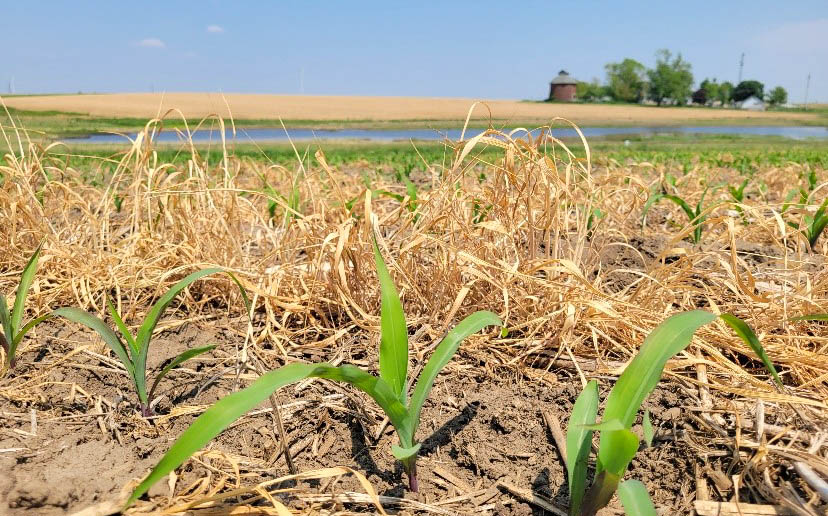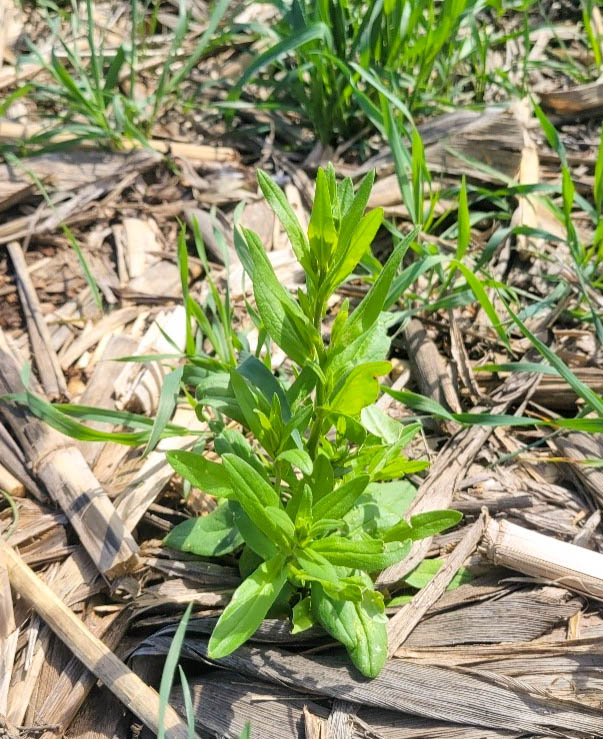
(Photo: Iowa Soybean Association)
Stacking benefits for cover crop success
August 1, 2024 | Evan Brehm, CCA
Cover crops are on the rise in Iowa. In 2014, approximately 400,000 acres of cover crops were planted. One decade later, Iowa farmers planted approximately 3.8 million acres of cover crops. What is with the 850% increase in 10 years? Cost share programs and long-term agronomic benefits. Cost share programs have intensified financial incentives from various public and private organizations over the years. Farmers can stack some of these programs together, depending on funding source, which strengthens farm profitability.
While financial incentives are one piece of the puzzle, another critical piece is agronomic and environmental benefits. Here are four examples:
- Reducing Soil Erosion: Planting a cover crop protects the soil from wind and water erosion. Iowa has the potential to lose 5 tons of topsoil per acre per year. Cover crops, depending on height, reduce soil erosion anywhere from 31-100%, according to the Sustainable Agriculture Research and Education program.

- Controlling Nutrient Runoff: As we work toward our goals of reducing nitrogen and phosphorus runoff from fields, cover crops have been shown to reduce both nutrients by 45%. Robust water monitoring/sampling at the Iowa Soybean Association has proven this theory. The percentage of reduction varies with rainfall, soil type, fertilizer application type, height of the cover crop and cover crop species. Farmers and landowners are encouraged that cover crops will keep nutrients in place, in the field, where they are best used.
- Suppressing Weeds: Waterhemp and marestail are two of several herbicide-resistant weeds in Iowa. Cover crops can shade out early emergence of winter annuals and, over time, reduce herbicide costs.
- Increasing Soil Organic Matter: The higher the percentage of organic matter, the greater fertilizer cycling and water holding capacity. Cover crops produce root exudates that build organic matter over time. Farmers who reduce their tillage and add cover crops note that the color of their soil changes as the organic matter increases in as short as a few years.
In Iowa, 90% of the cover crop acres contain cereal rye. It is the king cover crop because it is winter hardy, has a robust root system and is generally controlled well with glyphosate. Another common cover crop in Iowa are oats. Oats will winter kill, which is comforting for first time cover croppers or those concerned about control in the spring. Oats can be seeded at 60-70 lbs./acre.
Cover crop cocktails
These single species covers or multi-species mixtures can be planted anytime from Sept.1 through Nov. 1. Farmers should adhere to NRCS guidelines in their county; seeding rate requirements may vary if involved in a NRCS program.
Straight Grass
Three options — cereal rye 60 lbs./acre, winter wheat 60 lbs./acre or oats 65 lbs./acre.
Notes: Cereal rye and winter wheat are winter hardy. Oats will winter kill unless conditions hinder fall growth and encourage spring germination depending on temperatures and moisture. Excellent erosion control and overall soil health benefits. These choices can be controlled by glyphosate as a burndown prior to planting or as first herbicide pass followed by a post application.
Soil Saver
Two options — cereal rye or winter wheat 50 lbs./ acre, radish 1 lb/acre, winter camelina 4 lbs./acre or annual rye 20 lbs./acre, radish 1 lb./acre, winter camelina 4 lbs./acre.
Notes: Winter hardy grasses provide months of armor for the soil. Radish will bust compaction layers in no-till systems. Winter camelina draws up phosphorus locked in soil and is an over wintering brassica species.
Annual rye germinates well in a drought year and may be a better option for flying on with a drone due to weight restrictions. Annual rye can winter kill depending on snow coverage in the winter. Terminate with herbicide early in the spring before flowering when leaves become hard to penetrate.
Nitrogen Fixer
Cereal rye or winter wheat 45 lbs./acre, hairy vetch or red clover 10 lbs./acre, radish 1 lb./acre.
Notes: Geared toward a subsequent crop of corn, this cocktail can fix nitrogen for corn and farmers can conduct soil testing to determine nitrogen availability to the corn crop. The Late-Spring Soil Nitrate Test can be used to determine available nitrogen for a corn crop and guide decisions on in-season nitrogen applications. Nitrogen is fixed by legumes like hairy vetch and red clover. Depending on growing conditions and the timing of termination, nitrogen fixation can exceed 100 pounds, according to Michigan State University.
Back